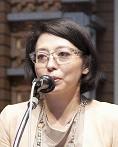Handing Down Japanese Kōgei Over 100 Years
October 19, 2016
Ms. Tomoko Iwaseki
Managing Director, The Creation of Japan
Incorporated Association
�� The Creation of Japan (COJ) is an incorporated association launched three years ago and works to ��hand down kōgei (traditional arts and crafts of Japan) over the century�� through various initiatives networking different parts of Japan. Mr. Hideki Hayashida (former Commissioner for Cultural Affairs) is our Representative Director. COJ aims to revitalize Japanese kōgei and improve the quality of works through creating new markets.
The Creation of Japan (COJ) is an incorporated association launched three years ago and works to ��hand down kōgei (traditional arts and crafts of Japan) over the century�� through various initiatives networking different parts of Japan. Mr. Hideki Hayashida (former Commissioner for Cultural Affairs) is our Representative Director. COJ aims to revitalize Japanese kōgei and improve the quality of works through creating new markets.
��COJ has three main activities. One is the ��kōgei masters�� circle�� where artists and virtuosos gather to socialize, enjoy and encourage the younger generation to better understand and appreciate kōgei. I must say kōgei craftspeople and artists suffer from a sense of stagnation today, so we hope the circle will encourage them and stimulate innovation and creativity. The second activity is organizing the ��21st Century Takagamine Forum�� that brings together organizations from different sectors across the country to celebrate and experience kōgei. The Second Forum will start in three days with the participation of 100 organizations, including national and public art museums, educational institutions, commercial facilities and our supporter companies. Around 300 events will be held during the 100-day-period. As our third activity, we launched on the development of ��Japan Kōgei Portal Navigation�� that compiles data of artists and ateliers and connects different entities including museums and educational institutions.
��I have been working as an art dealer over thirty years. When I was fourteen, my mother started an art gallery and I became her assistant. We have bought pieces of art work and sold them to clients across the country. I have built long-term relationships with clients and received many different requests, which led me to become a director of construction operation and management that include carpentry, designing and lighting. Five years ago, I met the then Director General of the National Museum of Western Art Prof. Masanori Aoyagi. I was inspired by his belief that kōgei constitutes the core of Japanese culture and it has universal value that transcends cultural borders. I was asked to help him construct a new national museum themed on kōgei and to make it a profitable project to build a sustainable future for kōgei. I became convinced of the challenging reality of kōgei.
��I must say kōgei faces a crisis as its supply of materials and tools is decreasing dramatically and the number of successors is plummeting. Some artists managed to expand their scope of activities and sales overseas, yet there is no systematic support in Japan to facilitate their networking with overseas counterparts. I must also emphasize that the rapidly changing lifestyle poses the biggest challenge for the younger generation to appreciate the attractiveness of kōgei. For example, an increasing number of children have never sat on a tatami floor. We must teach them how to enjoy and appreciate traditional Japanese lifestyle and art.
��My experience of working for COJ over three years has taught me that the world of kōgei is split into the industrial and art sectors with separate ministries in charge of its administration. There exist multiple administrative entities, educational institutions, localities, organizations and artists that are faced with the same challenges yet fail to tackle them in a concerted manner. This all amounts to a sense of stagnation. I felt the need to facilitate networking among information, people, industries, new technology and tradition to lay a foundation for a collaborative approach. I also worked to make contacts with companies to stimulate innovative ideas. Such networking led to a scheme to establish an organization to promote kōgei in a holistic manner, based on the principles of neutrality and transparency. COJ listens attentively to others and strives to connect people.
��As I close my speech, let me share the words by two prominent artists that give me moral support as I undertake different activities. I had a chance to ask Prof. Tadashi Kobayashi, a prominent art historian, whether kōgei artists of today have undergone regression from those of the Edo era. He responded ��the value of arts change with the times. Many of the art works I study date back scores of centuries. For example, a work that has survived 300 years has gone through several wars and disasters. It means such a work has a power to make people conserve it and I feel deep reverence. You should try to hand down many art works of excellence to different families so that they can appreciate and cherish them over many years.��
��Tōkō Shinoda is a world-renowned abstract painter still active at the age of 104. Her works merge traditional calligraphy with modern abstract expression. She has observed many artisans of traditional Japanese paper, sumi ink, ink brush and kimono pass away or give up their career. She taught me that ��art should bring joy and brightness to artisans who support artists.��
��I get motivated by these words to think ahead over 100 years and to work in collaboration with others. I hope to get your understanding and support for our activities.